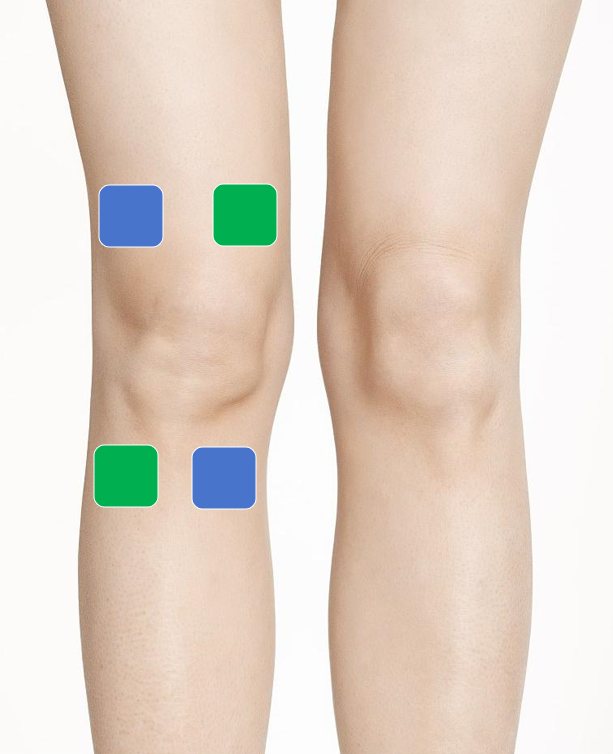1.What is OA(Osteoarthritis)?
Background:
Osteoarthritis (OA) is a disease that affects synovial joints causing degeneration and destruction of hyaline cartilage. To date, no curative treatment for OA exists. The primary goals for OA therapy are to relieve pain, maintain or improve functional status, and minimize deformity. Transcutaneous electrical nerve stimulation (TENS) is a noninvasive modality that is commonly used in physiotherapy to control both acute and chronic pain arising from several conditions. A number of trials evaluating the efficacy of TENS in OA have been published.
Osteoarthritis (OA) is a disease based on degenerative changes. It mostly affects middle-aged and elderly people, and its symptoms are red and swollen knee pain, pain up and down stairs, knee pain and discomfort when sitting up and walking. There will also be patients with swelling, bouncing, effusion, etc., if not treated in time, it will cause joint deformity and disability.
2.Symptoms:
*Pain: Patients with excess weight experience significant pain, particularly when squatting or ascending and descending stairs. In severe cases of arthritis, there may be pain even at rest and upon waking from sleep.
*Tenderness and joint deformity are the predominant indicators of osteoarthritis. The knee joint may exhibit varus or valgus deformities, along with enlarged joint bone margins. Some patients may have limited extension of the knee joint, while severe cases can result in flexion contracture deformity.
*Joint locking symptoms: Similar to meniscus injury symptoms, rough articular surfaces or adhesions can cause some patients to experience loose bodies within the joints.
* Joint stiffness or swelling: Pain leads to restricted movement, resulting in joint stiffness and potential contractures leading to deformity. During the acute phase of synovitis, swelling affects joint mobility.
3.Diagnosis:
Diagnostic criteria for OA include the following:
1. Recurrent knee pain within the past month;
2. X ray (taken in a standing or weight-bearing position) revealing joint space narrowing, subchondral osteosclerosis, cystic changes, and formation of osteophytes at the joint margin;
3. Joint fluid analysis (performed at least twice) showing cool and viscous consistency with white blood cell count <2000/ml;
4.Middle-aged and elderly patients (≥40 years old);
5.Morning stiffness lasting less than 15 minutes;
6.Bone friction during activity;
7. Knee end hypertrophy, local swelling to varying degrees, reduced or limited range of motion for flexion and extension.
4. therapeutic schedule:
How to treat OA with electrotherapy products?
The specific use method is as follows(TENS mode):
①Determine the right amount of current: Adjust the current strength of the TENS electrotherapy device based on how much pain you feel and what feels comfortable for you. Generally, start with a low intensity and gradually increase it until you feel a pleasant sensation.
②Placement of electrodes: Put the TENS electrode patches on or near the area that hurts. For OA pain, you can place them on the muscles around your knee or directly over where it hurts. Make sure to secure the electrode pads tightly against your skin.
③Choose the right mode and frequency: TENS electrotherapy devices usually have a bunch of different modes and frequencies to choose from. When it comes to knee pain, you can go for continuous or pulsed stimulation. Just pick a mode and frequency that feels comfortable for you so you can get the best pain relief possible.
④Time and frequency: Depending on what works best for you, each session of TENS electrotherapy should typically last between 15 to 30 minutes, and it’s recommended to use it 1 to 3 times a day. As your body responds, feel free to gradually adjust the frequency and duration of use as needed.
⑤Combining with other treatments: To really maximize knee pain relief, it might be more effective if you combine TENS therapy with other treatments. For example, try using heat compresses, doing some gentle neck stretches or relaxation exercises, or even getting massages – they can all work together in harmony!

Instructions for use:The cross electrode method should be selected.Channel1(blue), it is applied to the vastus lateralis muscle and the medial tuberositas tibiae. Channel2 (green) is attached to the vastus medialis muscle and the lateral tuberositas tibiae.
Post time: Dec-04-2023






